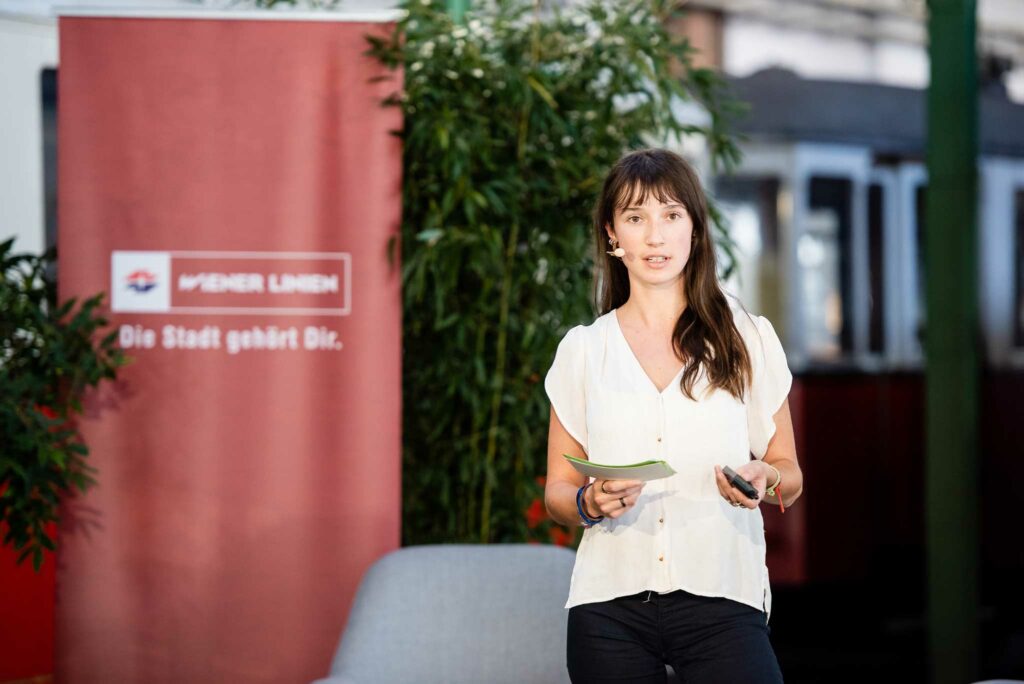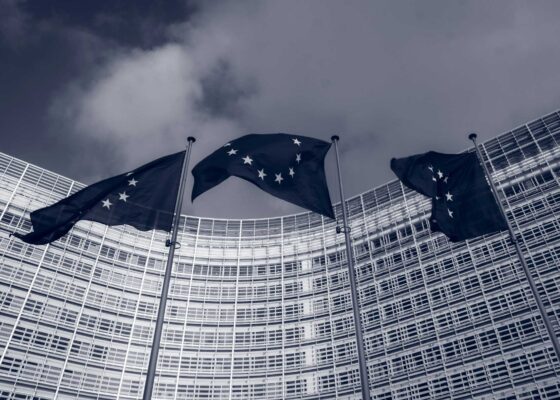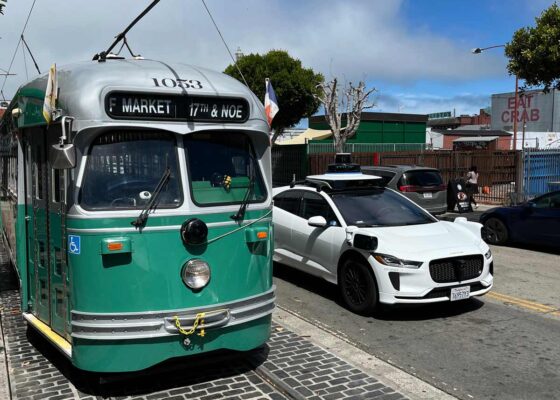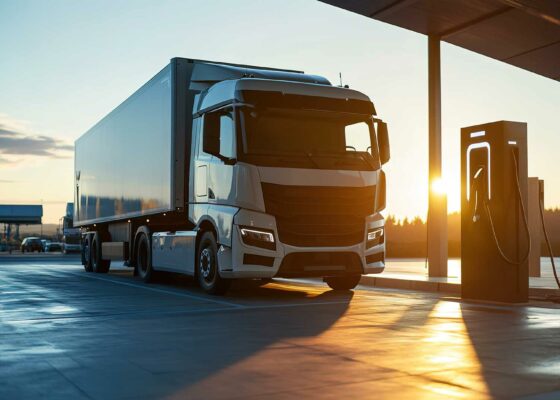Around the question “Clean, quiet, safe: “What mobility mix does a livable city need?” Wiener Linien invited to an exciting day in the Remise of the Transport Museum in Vienna, moderated by Alexander Hotowy, Managing Partner of accilium. Unfortunately, due to Corona, the keynotes and the panel had to be held in front of empty seats – originally the event was planned with 100 people on site. But with the livestream it became more than 300 viewers – thanks to digitalization! Questions could be asked and comments made via the chat, so that interaction and the resulting exciting impulses were possible even without an on-site presence.
(c) Copyrights | Photo credits, Zsolt Marton
The welcome by the two managing directors of Wiener Linien was followed by a total of four keynotes on the topics of “Climate-friendly and sustainable mobility now” (Mira Dolleschka, Fridays for Future),
“5 ingredients for the diverse mobility of tomorrow” (Claudia Falkinger, Women in Mobility), “40-40-20: The ideal dimensions of a livable city?” (Lukas Lang, 3420 AG and Univ.Prof. Martin Berger, TU Vienna), and “A fallen wheel from China – or an integrated mobility concept after all” (Alexandra Reinagl, Wiener Linien). The crowning finale of the day was the discussion panel on the motto of the entire event, the content of which was designed and moderated by accilium, management consultancy focusing on the mobility of the future.

Corona crisis vs. climate crisis
Alexandra Reinagl, Managing Director of Wiener Linien, opened the event with an important note: The Corona pandemic has brought drastic changes for all of us in recent months – and has pushed the management of another, even more serious crisis somewhat into the background: The threat of climate change.
As soon as mobility becomes a topic, the question of the currently clearly too high CO2 emissions of transport arises: Even if the city of Vienna has set itself the goal in the urban development plan “STEP 2025” of reducing CO2 emissions to 0 (zero!) by 2050, this does not yet mean that we are – as Martin Blum from the Mobility Agency Vienna puts it – already on “target achievement course”.
Barbara Laa from the initiative Platz für Wien takes a similar view: She finds STEP 2025 “very commendable, with great goals. The problem is that we won’t achieve it if we carry on as we are. More simply needs to be done.” That’s why Place for Vienna has developed 18 demands in a 10-year plan to lay the groundwork for the necessary reduction in traffic emissions.
Mira Dolleschka from Fridays for Future already makes her demand unmistakable in the title of her keynote: “Climate-friendly and sustainable mobility now!” Among other things, she criticizes the historically grown, often categorical priority of cars over other road users, and draws attention to the resulting consequences, such as the high space requirements of cars in public space.
(c) Copyrights | Photo credits, Zsolt Marton
“If you buy furniture, you put it in your home. If you buy a car, you put it in a public space.” (Günter Steinbauer, Wiener Linien)
Here it becomes clear: on the way to the future mobility mix, it is not exclusively about achieving the climate targets. To make cities, especially Vienna, even more livable in the future, both Fridays for Future and “Platz für Wien” call for a redistribution of space in favor of pedestrians and cyclists.
“On Vienna’s roads, the car must no longer be the most prominent road user. (…) Safe, freedom-promoting, sustainable mobility for all only works if driving is made less attractive.” (Mira Dolleschka, Fridays for Future)
The modal split must take into account all transport users
Access to public transport and other means of transportation must be barrier-free and affordable. Streets should invite people to linger and be a place of encounter. According to “Platz für Wien”, this includes seating for short rest breaks, trees that provide shade, as well as a continuous bicycle network with appropriately wide bike lanes, and traffic-calmed residential areas where people can sleep with the windows open and where children can be let outside to play with a clear conscience. This can only succeed if the share of cars in the modal split is reduced.
“The future of the city is non-fossil and low-car” (Martin Berger).
(c) Copyrights | Photo credits, Zsolt Marton
Car-sharing models are predestined for this – but Nico Prugger, CEO of ELOOP, a car-sharing provider with an all-electric fleet, criticizes the fact that car-sharing providers whose business model helps to increase vehicle utilization and thus reduce the overall number of vehicles in the city have to pay comparatively high monthly parking fees – regulatory hurdles that make it difficult for sensible initiatives to gain a foothold compared to veteran players.
And although all speakers at the Austrian Roadmap 2050 agree that cars and especially fossil fuels will have to play a much smaller role in the mobility mix of the future and that the car-free inner city, especially in Vienna, is the topic of the day, it will not be possible to do without cars altogether, even if cars will probably be owned less by individual families or households in the future and will be accessible via sharing models. ELOOP has developed a blockchain token with which one can participate in the company from around €250 and also earn money with it. According to Nico Prugger, CEO of ELOOP, this is the only way “real” sharing – decentralized vehicle ownership – works.
The ideal mobility mix for the city of Vienna
“40-40-20: The ideal dimensions of a livable city?” (Lukas Lang and Univ.Prof. Martin Berger)
In the newly emerging Urban Lab aspern Die Seestadt in Vienna’s 22nd district, an answer has already been found to the question of what the ideal mobility mix for the city should look like in the future: Under the motto 40-40-20, in the future only 20% of journeys are to be covered by motorized private transport, while 40% each are to be covered by public transport or on foot or by bicycle. Even if the new district – with up to 25,000 residents in the future (today: approx. 8,000 residents) and with 20,000 jobs – does not quite reach this goal today, a lot is being done to build a functional city with short distances and an integrated mobility concept. An elementary component of the concept is a design of public spaces that focuses on pedestrians and cyclists, as well as the expansion of existing mobility services, such as the U2, via bicycle rental and car-sharing services. The fact that this also comes at the expense of parking spaces and thus the satisfaction of car owners is consciously accepted in favor of climate friendliness and resource conservation.
“For the mobility ecosystem of the future to work and for cities to become cleaner, quieter and safer, many different players will have to cooperate in a new and challenging complexity. The exciting question is: Who will take which role in this, and who will pull the strings as orchestrator?” (Alexander Hotowy, accilium)
(c) Copyrights | Photo credits, Zsolt Marton
Alexandra Reinagl and Günter Steinbauer from Wiener Linien agree: Public transport is the central lifeline of the city, but other modes of transport and mobility providers should be seen as complementary and important – instead of a competitive situation, it is important to create a functional environmental network by Wiener Linien as a central enabler offering a mobility platform. On the one hand, this role in the ecosystem naturally includes ensuring the smoothest possible operation and the expansion and optimization of the public transportation network, which is currently being targeted with the expansion of the U2 and U5 line interchange, among other things.
But that’s not all – as an orchestrator, integrative action is needed: with the Wien Mobil app and the expansion of Wien Mobil stations, Wiener Linien is already enabling customers to have a seamless mobility experience in which multimodality becomes easily accessible. But not all players in the mobility mix are playing along here yet: for example, some car-sharing operators of large OEMs are not ready to open up their systems. In addition, micromobility providers have been in the game for a few years now, distributing e-scooters free-floating across the city, for example, and thus bringing new options into play on the one hand, especially for the first and last mile, but at the same time still causing one or two problems when, for example, sidewalks are blocked with them. Today, there is still a lack of appropriate regulations, which will have to be solved in the future by politicians in close cooperation with other mobility providers and users.
An open mobility ecosystem is the right way to go
Claudia Falkinger from Women in Mobility (keynote: 5 ingredients for the diverse mobility of tomorrow) is also sure that the best solutions can be created together in an open ecosystem and taking into account many different perspectives. With the Community creates Mobility, created in spring 2019, an open system of now more than 80 organizations from industry, startups, academia, civil society and many more committed mobility thinkers was therefore initiated: Only if politics creates a framework for trying out and implementing solutions, companies are willing to experiment and live open error cultures with regard to the development of tomorrow’s mobility, and users actively contribute with ideas and feedback, can these challenges be mastered in the best possible way.
To the official event: Sauber, leise, sicher: Welchen Mobilitätsmix braucht die lebenswerte Stadt?
(c) Copyrights | Photo credits, Zsolt Marton










 ISO/IEC 27001:2013 certified
ISO/IEC 27001:2013 certified